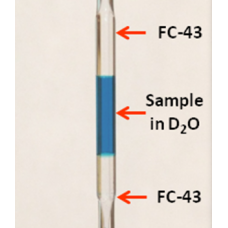Shopping Cart
0 item(s) - $0.00Load Bruker CryoFit Flowcells with One-Minute NMR
Add to Compare
Ask a question
Your Name:Your Email:
Your Question: Note: HTML is not translated!
Enter the code in the box below:
At SMASH 2012, Protasis introduced, CryoFlow NMR, an exciting new way to load flowcell inserts for Bruker and Agilent cryogenically-cooled probes. In this work, we were able to clearly show the advantages of both native (same push solvent as the sample) and segmented flow (for 30uL active volume) flow inserts using a Bruker CryoFit flowcell. Many pharma companies and university research groups now have cryoprobes and it is very quick and easy to drop a flowcell insert into them to enable plate/vial automation using One-Minute NMR. In particular, this is a new alternative to CapNMR microcoil flowcells for larger-volume life science applications.
Note that both native and segmented flow configurations work exceptionally well and you can go back and forth with only minor plumbing changes (e.g. native would optimally use a smaller tubing ID to limit dispersion). Generally, the segmented (aka Zero Dispersion Sample Loading) will give you about a 2X advantage in S/N (by exactly filling the active volumeIn addition, it will greatly reduce your deuterated solvent consumption and let you maintain the original concentration of your sample without diluation (e.g., very useful in screening). The fluorinert is typically less expensive than deuterated solvents, depending upon type and your supplier. FC-43 is closely matched (~1% for D2O) and we believe we can improve upon this further by mixing different cuts of the fluorinerts (which we do now in the microcoil probes).
Note the flowcell is fluorosilanized and this coating will need to be replenished occasionally (~3 months). This is a simple cleaning and soaking protocol that you can do (or we can do for you as part of our support plan). The coating can be removed and the coated flowcell works with native loading also. Although this is a specialized chemistry, we are finding it to be simple and effective.
Write a review
Your Name:Your Review: Note: HTML is not translated!
Rating: Bad Good
Enter the code in the box below:
The microNMR Outlet © 2025
















